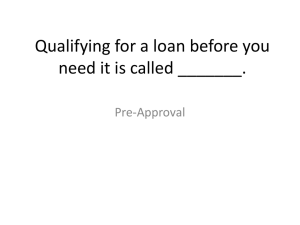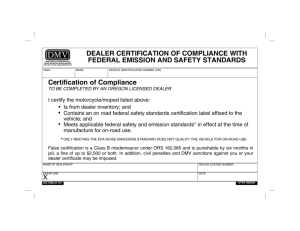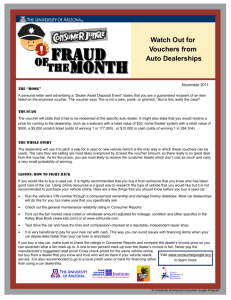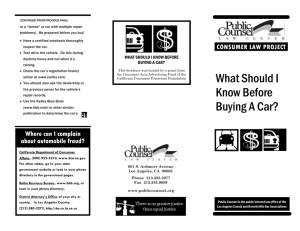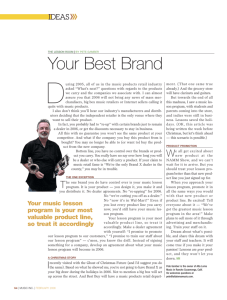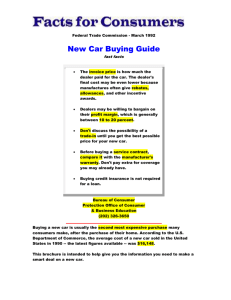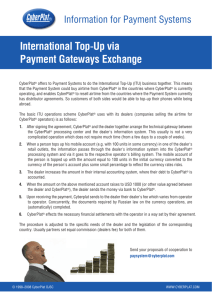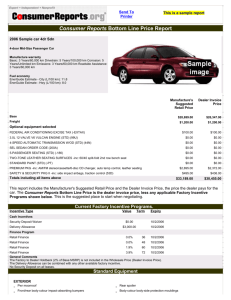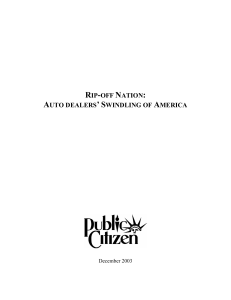Take the Wheel: Get the Best Car Deal
advertisement
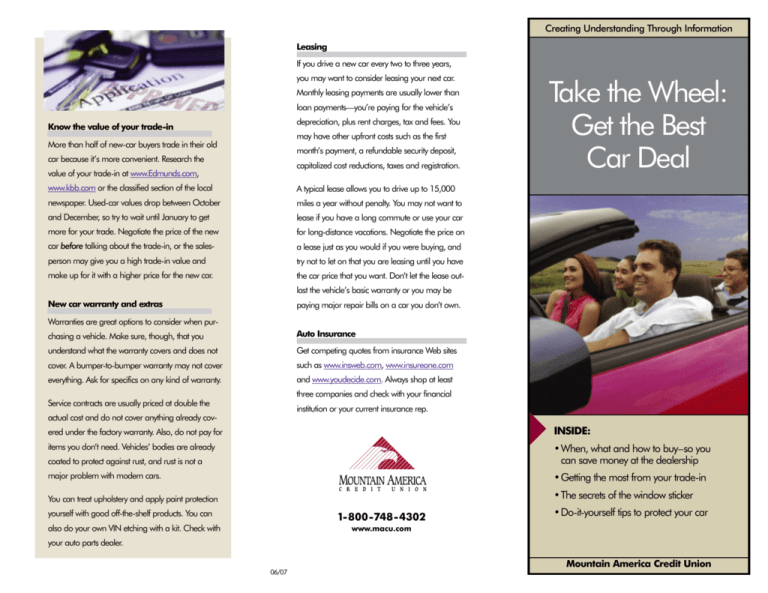
Creating Understanding Through Information Leasing If you drive a new car every two to three years, you may want to consider leasing your next car. Monthly leasing payments are usually lower than loan payments—you’re paying for the vehicle’s depreciation, plus rent charges, tax and fees. You Know the value of your trade-in may have other upfront costs such as the first More than half of new-car buyers trade in their old month’s payment, a refundable security deposit, car because it’s more convenient. Research the capitalized cost reductions, taxes and registration. value of your trade-in at www.Edmunds.com, www.kbb.com or the classified section of the local A typical lease allows you to drive up to 15,000 newspaper. Used-car values drop between October miles a year without penalty. You may not want to and December, so try to wait until January to get lease if you have a long commute or use your car more for your trade. Negotiate the price of the new for long-distance vacations. Negotiate the price on car before talking about the trade-in, or the sales- a lease just as you would if you were buying, and person may give you a high trade-in value and try not to let on that you are leasing until you have make up for it with a higher price for the new car. the car price that you want. Don’t let the lease out- Take the Wheel: Get the Best Car Deal last the vehicle’s basic warranty or you may be New car warranty and extras paying major repair bills on a car you don’t own. Warranties are great options to consider when purchasing a vehicle. Make sure, though, that you Auto Insurance understand what the warranty covers and does not Get competing quotes from insurance Web sites cover. A bumper-to-bumper warranty may not cover such as www.insweb.com, www.insureone.com everything. Ask for specifics on any kind of warranty. and www.youdecide.com. Always shop at least three companies and check with your financial Service contracts are usually priced at double the institution or your current insurance rep. actual cost and do not cover anything already covered under the factory warranty. Also, do not pay for INSIDE: items you don’t need. Vehicles’ bodies are already coated to protect against rust, and rust is not a •When, what and how to buy–so you can save money at the dealership major problem with modern cars. •Getting the most from your trade-in You can treat upholstery and apply paint protection •The secrets of the window sticker yourself with good off-the-shelf products. You can 1-800-748-4302 also do your own VIN etching with a kit. Check with •Do-it-yourself tips to protect your car www.macu.com your auto parts dealer. Mountain America Credit Union 06/07 Getting the Best Car Deal Even with some increased repairs and maintenance costs, you Some of the best times to buy: could spend less per year buying a used car rather than a new You can save money by buying out-of-season vehicles or Auto dealers do everything they can to make buying a car one. Certified pre-owned vehicles offer the lower cost of a used models late in the year when a body style change is easy, but they also do their best to get top dollar from you. car and the peace of mind of a factory-backed warranty of imminent. Customer incentives are typically higher in the With a basic understanding of the auto-buying experience, three months to up to ten years. Do as much research on the summer and winter months. Consider buying around the you should be able to save yourself a lot of money. history of the used car as you can. Some good resources are last day of the month when dealers may be eager to www.carfax.com, www.autotrader.com and your local Department meet monthly quotas or at the end of the year when of Transportation office. dealers clear out inventory for tax reasons. Pricing… on the window sticker Pricing…NOT on the window sticker much you can afford. Be realistic and conservative with MSRP refers to the Manufacturer’s Suggested Retail Price. MSRP is Dealer’s true cost is the dealer invoice price (found at variable income, as it is not guaranteed. Keep all monthly the vehicle’s published retail or base price, without options, desti- www.nada.com), minus any incentives and holdbacks. A payments, including rent or mortgages, below 40% of nation charge or other fees. Dealers are free to sell the car at a close estimate of the dealer’s true cost is included in monthly take-home pay. Don’t forget about other vehicle higher or lower price—MSRP is simply the suggested price. Consumer Reports’ “New Car Price Reports.” Consider How much can you really afford? Before you start shopping for a vehicle, examine your credit history, check your income, get pre-approved and consider how you’ll use the car when determining how expenses. Consider the costs of licensing, registration, gas, maintenance, repairs and insurance. Optional equipment refers to features or packages for which you pay extra; you may be able to negotiate this price. Get pre-approved first A destination-charge fee covers the cost of delivering the vehicle Getting pre-approved for a car loan gives you an “upper from the factory to the dealership. Destination charges are typical- hand” during the price negotiations. Consider the loan ly non-negotiable and usually the same cost for all models amount and car price that’s best for your budget. Keep within a brand regardless of the actual shipping distance. the pre-approved amount to yourself until after negotiations with the dealer are complete. This prevents the dealer from inflating the price of the car to match your loan amount. A market adjustment is a fee the dealer adds on, typically to cars that are in high demand, to make additional profit. You can try to negotiate this figure. However, if the vehicle is selling well, the dealer doesn’t have much incentive to work with you. starting negotiations at 4% to 8% over dealer’s true cost. The true market value price reflects what others are paying for the car in your geographic area and can be found at www.Edmunds.com/products/tmv. To get the best price, negotiate up from the dealer’s true cost, rather than down from the sticker price. A rebate is a direct-to-buyer incentive from the manufacturer. Disregard the rebates when negotiating with the dealership because you’ll get it no matter what price you pay for the vehicle. A dealer incentive is money the manufacturer pays the New or Used? The sticker price is the total retail New cars depreciate the minute you drive them off the lot. price for the vehicle, including In fact, your car may lose 20% or more of its original MSRP, options, destination value in the first year. By the end of the fifth year, the value charge and market adjustments. of the car may fall by an average of 35.1% from the Dealers try to sell the car for as A holdback is a percentage of the MSRP that manufac- sticker price. The pace levels off after five years, so try to close to this price as possible or turers offer to dealers as a refund when the car is sold, keep the car at least that long to minimize the financial hit offer you a token discount or typically 2% to 3%. This means the dealer can still make of depreciation. manufacturer discount. a profit on a car sold for “invoice.” dealer for selling certain models, usually slow-selling models. This money can be passed on to the buyer in the form of a price reduction or kept as added dealer profit.
